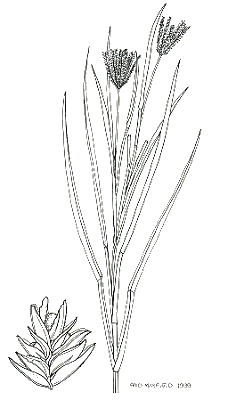Eleusine coracana* (L.) Gaertn. Fruct. Sem. Pl. 1: 8 (1788).
Classification. (GPWG 2001) : Subfamily Chloridoideae. Cynodonteae.
Basionym and/or
Replacement Name: Cynosurus
coracanus L., Syst. Nat. (ed. 10) 2: 875 (1759).
Type of Basionym or
Protologue Information: LT: Plukenet, Phytographia pl. 91, f. 5
(1691), LT designated by ?, cited by de Wet et al., Amer. J. Bot. 71
(4): 551 (1984).
Key references
(books and floras): [1952] C.A.Gardner, Flora of Western Australia 1
Gramineae (208), [2002] D.Sharp & B.K.Simon, AusGrass, Grasses of
Australia, [2002] J.Wheeler, N.Marchant & M.Lewington, Flora of the
South West (415 as E. corocan).
Illustrations:
[2005] K.Mallet (ed.), Flora of Australia 44B: Poaceae 3 (Fig.
74G-H).
Habit. Annual.
Culms erect, 50–200 cm tall, 5–20 mm diam. Leaves mostly basal. Ligule a
fringed membrane. Leaf-blades conduplicate, 30–60 cm long, 4–12 mm wide.
Inflorescence.
Inflorescence digitate or subdigitate, with spicate branches. Racemes 4–10,
erect, linear or oblong, incurved, 3–8 cm long, 4–15 mm wide.
Spikelets.
Spikelets sessile. Fertile spikelets many flowered, with at least 2 fertile
florets (3–9), comprising 3–9 fertile floret(s), with diminished florets at the
apex, ovate, laterally compressed, 4–10 mm long.
Glumes. Glumes
similar. Lower glume lanceolate, membranous, keeled, 1-keeled, winged on keel,
1–3 -nerved. Upper glume elliptic, 2–5 mm long, membranous, keeled, 1-keeled,
winged on keel, 5–7 -nerved.
Florets.
Fertile lemma 3–5 mm long, 3 -nerved (excluding subsidiaries). Palea 2 -nerved.
Lodicules present. Grain 1.5–2.5 mm long.
Continental
Distribution: Africa, Temperate Asia, Tropical Asia, Australasia, and
Pacific.
Australian
Distribution: Western Australia.
Western Australia:
Drummond, Menzies.
Notes.
Cultivated for food and drink, domestic use, traditional medicine and chemicals
(hydrocyanic acid). It is present in archeological records of early African
agriculture that date back 5000 years.
Roadside escapes are often small and slender,
but may be distinguished from E. indica by the broader spikes of closely
packed, non-shattering spikelets.
Mainly
cultivated, but occasionally occurs spontaneously. Collected from the wild in
the SW of WA; distributed throughout warm and temperate regions from Africa to
Japan; originating in Africa, and introduced into India about 3000 years ago.
Escapes from cultivation to become a weed in cultivated lands and other disturbed
places such as roadsides.


